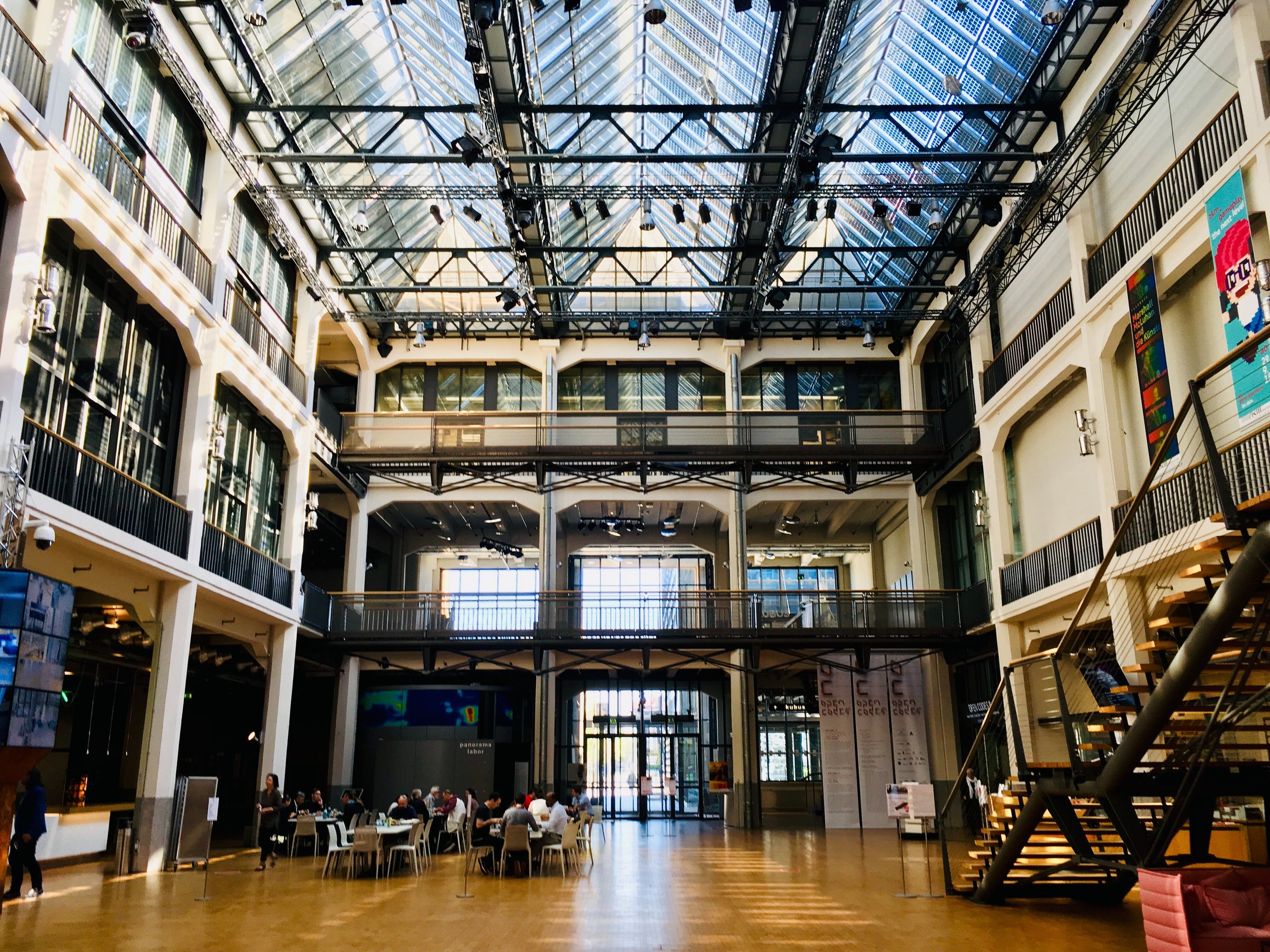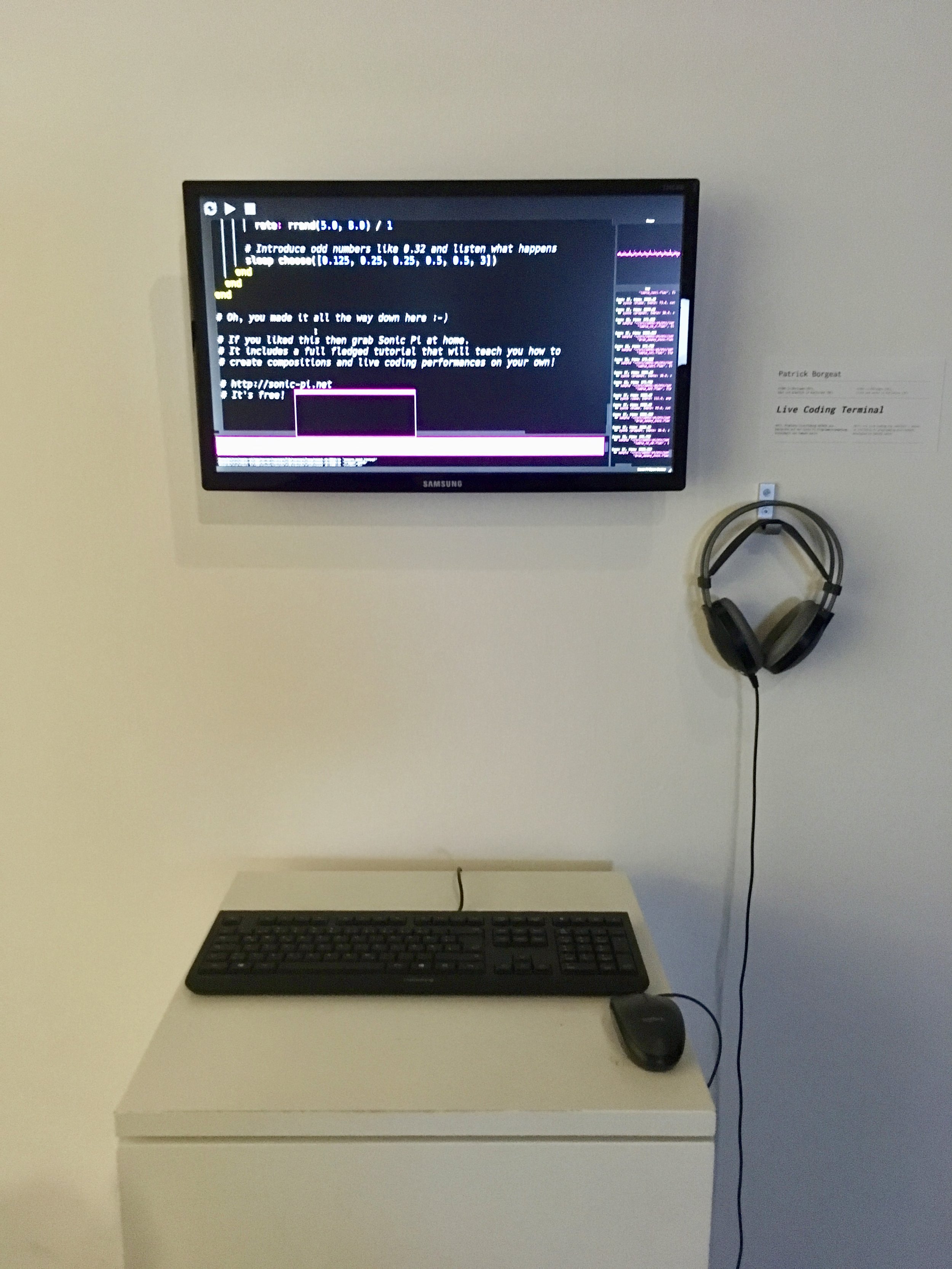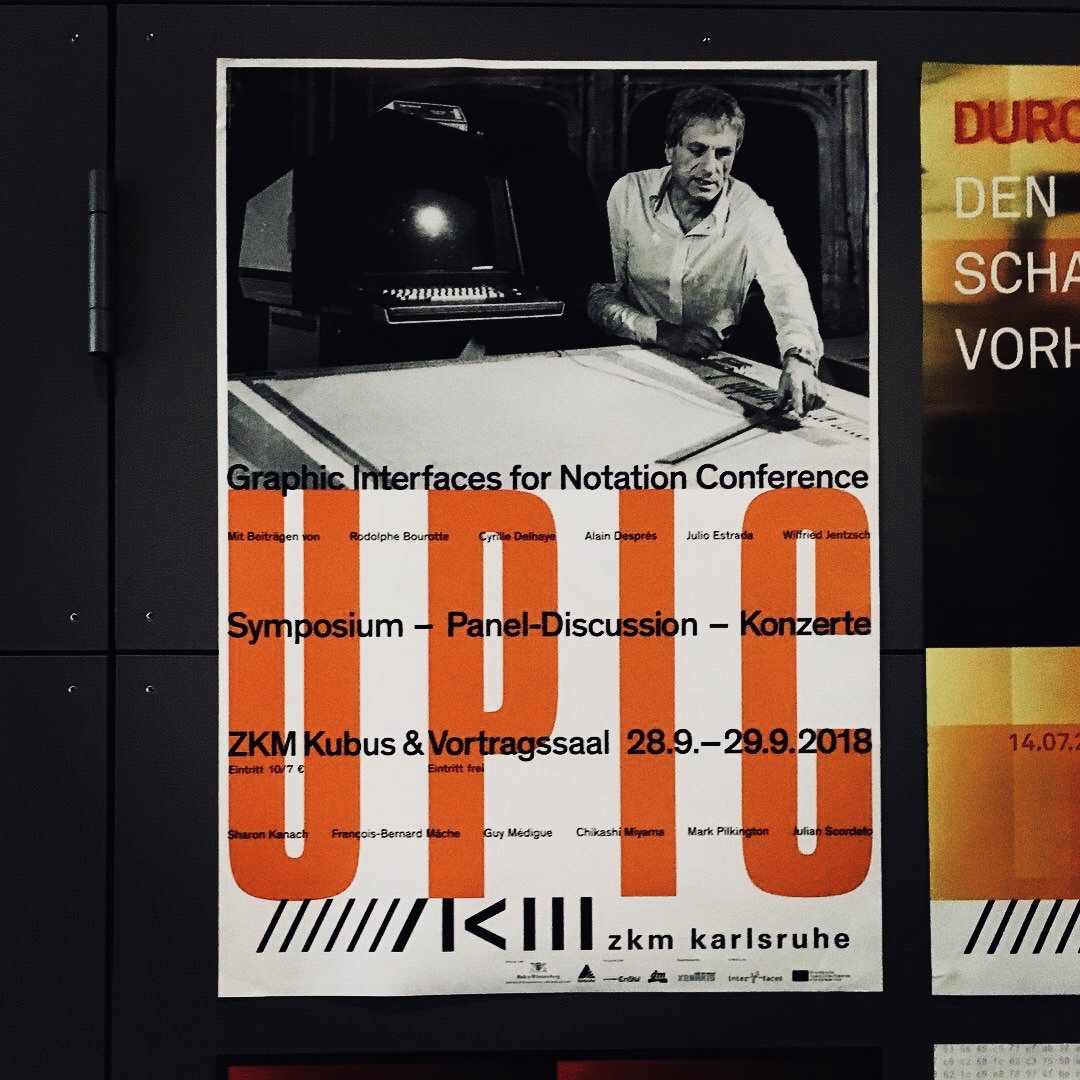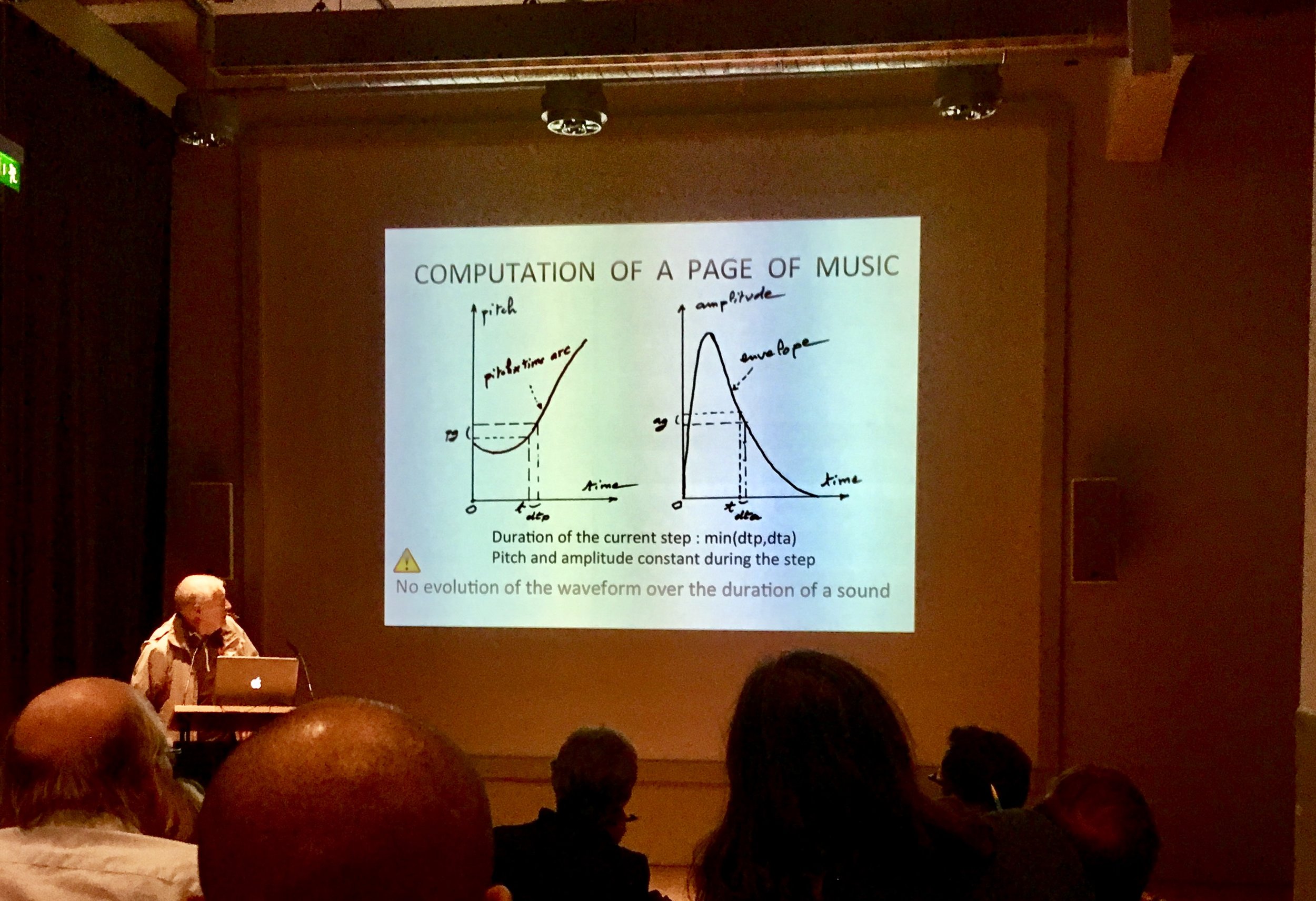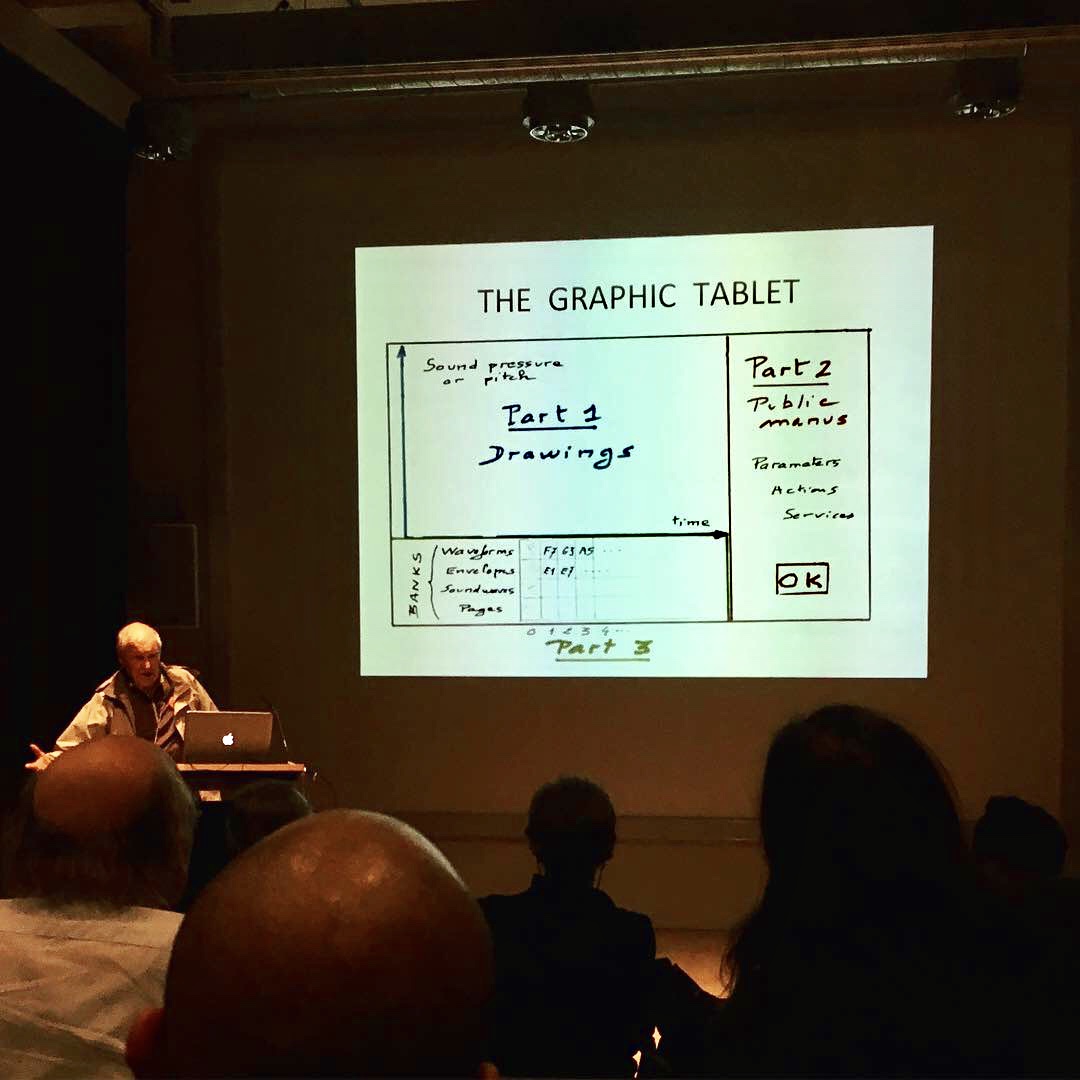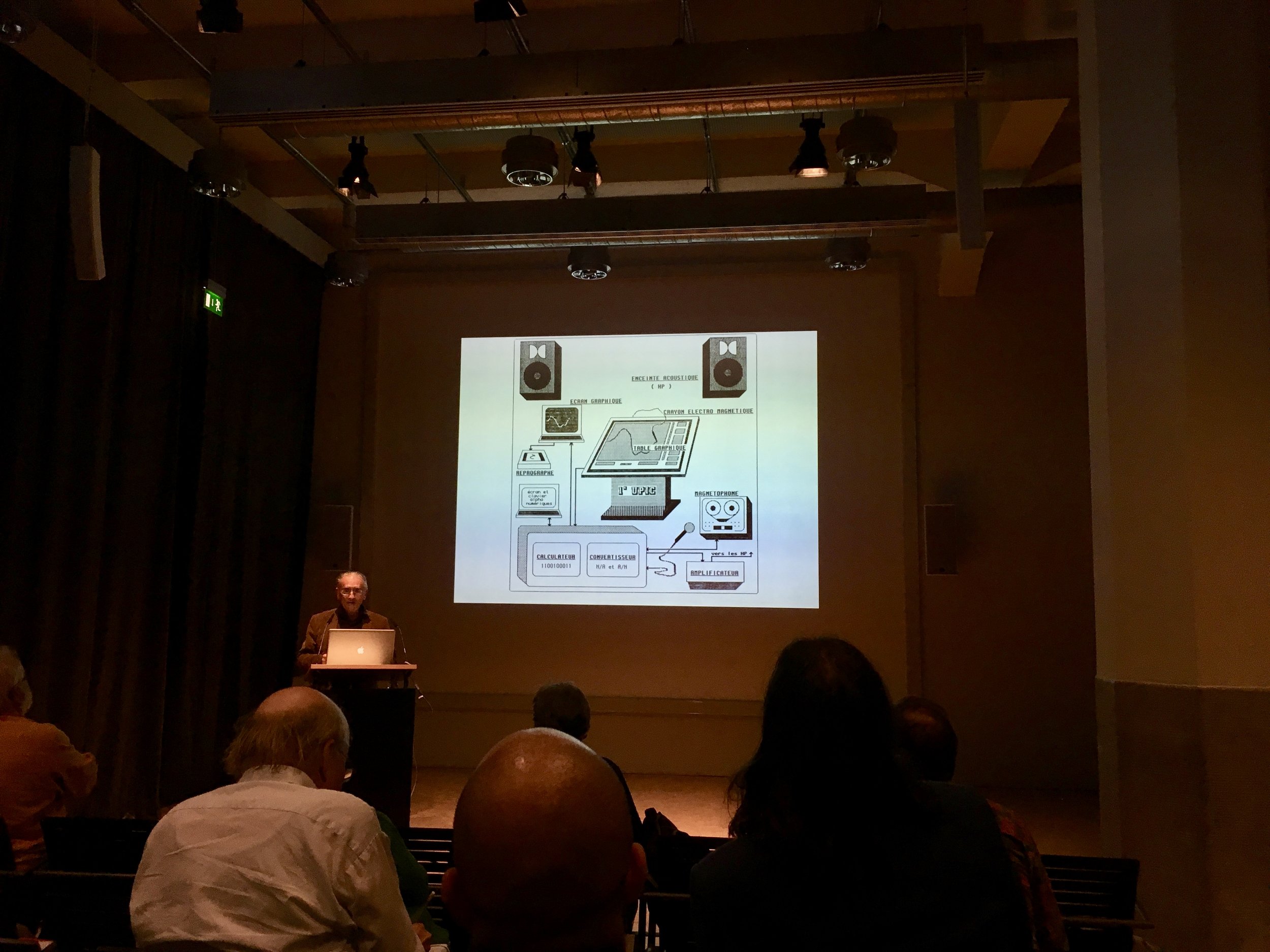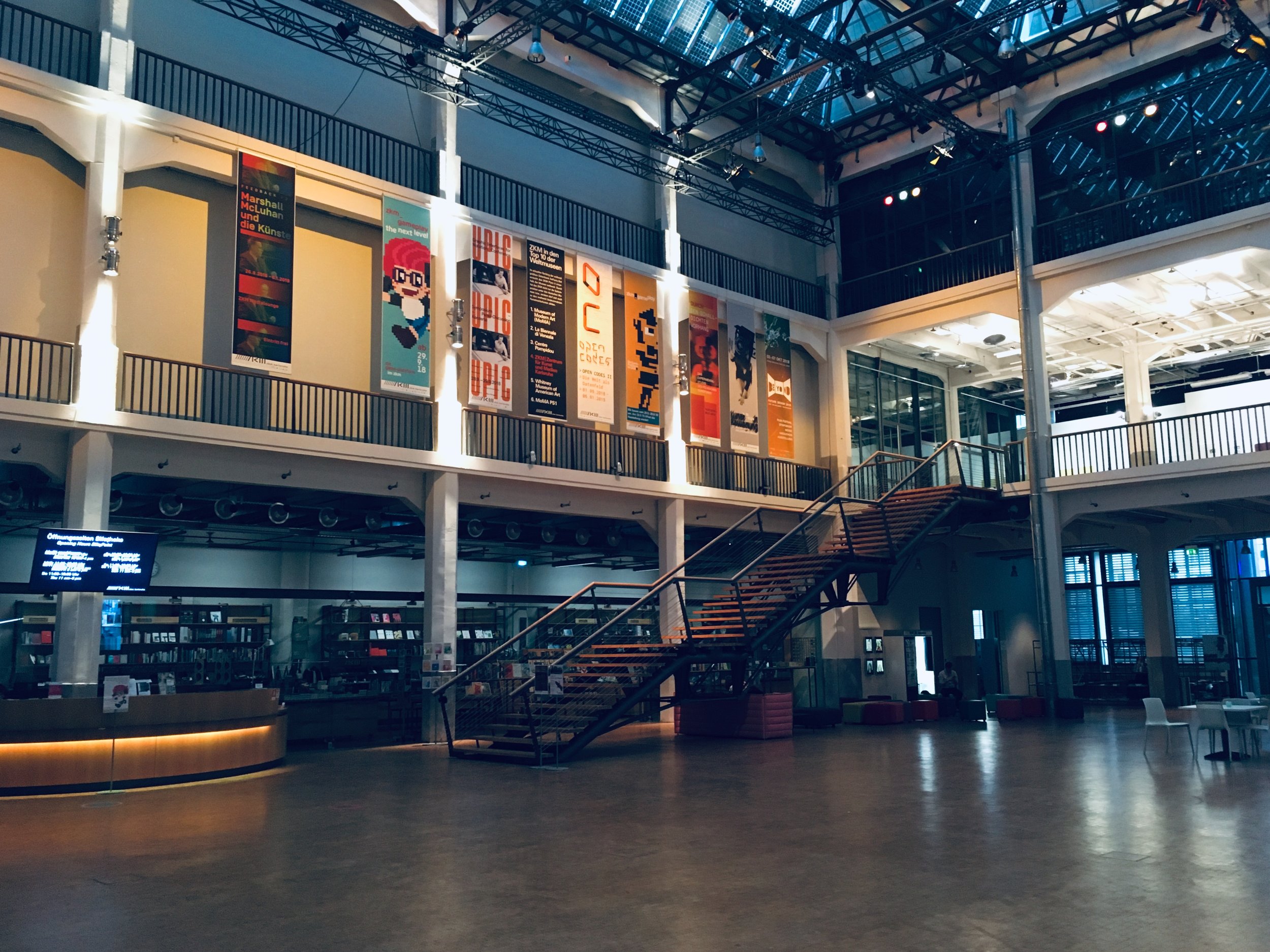
Research
My research explores relationships between musical and visual forms, both in theory and practice. In particular, I am interested in the applications of post-structural philosophy, visual studies, and art history to music based upon works (or processes) of visual art, privileging notions of medium, materiality, and cultural imagination in their discourse and analysis. Other research interests include musical semiotics and notation, music and politics, and the histories of (post)modernism.
Publications
Metcalf, T. ‘Imagetext, Indeterminacy, Iconoclasm: What Do Graphic Scores Want?’, Music in Art 48(1-2), Research Center for Music Iconography, City University of New York, 2023, 175-186.
Metcalf, T. ‘Between Audiation and Ekphrasis: Pascal Dusapin’s “False Trails”’, Tempo 75(305), CUP, July 2023, pp. 26-43.
Metcalf, T. ‘Cornelius Cardew's Camouflage and “Bun No. 2”’, Music Analysis, 42(1), March 2023, pp. 112-151.
Mathieson, D. & Metcalf, T. ‘Graphics, Extended Techniques, Timbral Diversity: Collaborative Approaches to Contemporary Organ Music’, RCO Journal 15, 2022, pp. 80-94.
Metcalf, T. ‘Anne Boyd at 75: A Celebration through the String Quartet’, Tempo, 75(297), Cambridge University Press, July 2021, pp. 35-47.
Metcalf, T. ‘Graphical Data Sets as Compositional Structure: Sonification of Colour Graphs in ‘RGB’ for clarinet and piano’, Leonardo, MIT Press, 2021, pp. 329-336
Metcalf, T. ‘Labyrinths, Liminality and Ekphrasis: The Graphical Impetus of Kenneth Hesketh’, Tempo(295), Cambridge University Press. January 2021. pp. 45-71
Metcalf, T. ‘Pixelation as a Teleological Strategy in Music Composition’, Principles of Music Composing 20, Lithuanian Academy of Music and Theatre, 2020, pp. 135-146.
Metcalf, T. ‘Graphical Ekphrasis: Translating Graphical Spaces into Music’, Question Journal, AHRC. September 2020, pp.78-91.
Conference Presentations
Metcalf, T. If We Do Not Succeed, What Does It Matter!: Analysing Cubism and/as Music, Picasso and Musical Modernity, Parador de Mojácar, Almeria / University of Melbourne, forthcoming, October 12-14 2023.
Speaker at roundtable: ‘Multimodality as Translation?’, Multimodal Translation in the Arts: (Multi)Modalities, Languages and Codes In/As Translation?, Cardiff University / Trinity Laban Conservatoire, 22-23 May 2023.
Metcalf, T. Composition and Visuality: Approaches in Theory and Practice, Reid School of Music, Edinburgh, April 2023.
Metcalf, T. Ekphrasis in the Work of Iannis Xenakis, Xenakis 22: International Centenary Symposium, Athens/Nafplio, May 2022.
Metcalf, T. Methods of Confronting the Parergon in Transmedial Art Music, PERLEGO: Methods of Research in Literature and the Visual Arts, Freie Universität, Berlin, 6th-8th April 2022,
Metcalf, T. Aesthetic synthesis in transmedial music: approaches, limitations, frameworks, Royal Musical Association Annual Conference, University of Newcastle, 14–16 September 2021.
Metcalf, T. The parergon of the ‘transmedial’ work: the intrinsic and extrinsic of music after art, Visualizing the Unseen: Music in Visual Culture, 20th International Conference of Association RIdIM, Lucerne, 27-29 August 2021.
Metcalf, T. ‘Ideograms’, ‘Augenmusik’, and Metaphorical Models: Reconsidering Astral Compositions through an Ekphrastic Lens, Birmingham Music Analysis Conference, University of Birmingham, 29–31 July 2021.
Metcalf, T. Towards an Extended ‘Musical Ekphrasis’: Determinate Graphical Processes in Contemporary Music, SMI Plenary Conference, University College Dublin, 29–31 October 2020.
Metcalf, T. The (Dis)solution of Form: Processes of Pixelization in ‘Pixelation Variations’ (2020), 5th AHRC Interdisciplinary Conference “Form and Forgetting”, Cambridge University, 21–23 September 2020.
Metcalf, T. Applications of Sonification to 12–Tone Contexts. RMA/BFE Research Students’ Conference, The Open University, 9–11 January 2020.
Recordings
Metcalf, T. ‘Pixelating the River’, Something So Transporting Bright, Kreutzer Quartet, Métier (MEX 77132). January 2025.
Metcalf, T. ‘LIVING SENSE DATUM’ & ‘H(AI)KU’, Ben Parry (dir.), National Youth Choirs of Great Britain, NMC Recordings. January 2023.
Metcalf, T. ‘DISSOLUTION (X-XII)’, Daniel Mathieson, Lockdown Music: South East, NMC Recordings. June 2022..
Metcalf, T. ‘Worcester Service’, Allery, T. (dir.), Qui Christi Vestigia Sunt Secuti. Worcester College Chapel Choir. Herald. 2019.
Other
Thomas Metcalf: AI-generated haikus & surrealism, NMC Recordings, January 2023.
Young Composers Blog #3, a blog post detailing some time spend on NYCGB’s composers programme, November 2022.
Krasis: Re-using Parts, a blog post by undergraduate students Chloe Green & Dominic Madera reflecting upon a symposium given during my Junior Teaching Fellowship at the Ashmolean Museum, February 2022
Krasis: Belonging Together, a blog post by postgraduate student Cecily Fasham reflecting upon a symposium given during my Junior Teaching Fellowship at the Ashmolean Museum, November 2021.
Vignettes of a Pixelated River Nos. 3 & 4, published 17th November 2021
In Conversation with Anne Boyd, an interview as part of my project ‘Pixelating the River’, 1st February 2021.
Interview with Vale of Glamorgan Festival, as part of the Peter Reynolds Composers’ Studio, published 24th December 2020.
Fluvial Journeys: The Musical Possibilities of a River, published 22nd July 2020.
RGB: A brief introduction to data sonification as compositional process, published 2nd April 2020.
This page will be updated as research progresses.
Notation, Decolonial Resistance, and the Political Sovereignty of ‘Late Liberalism’
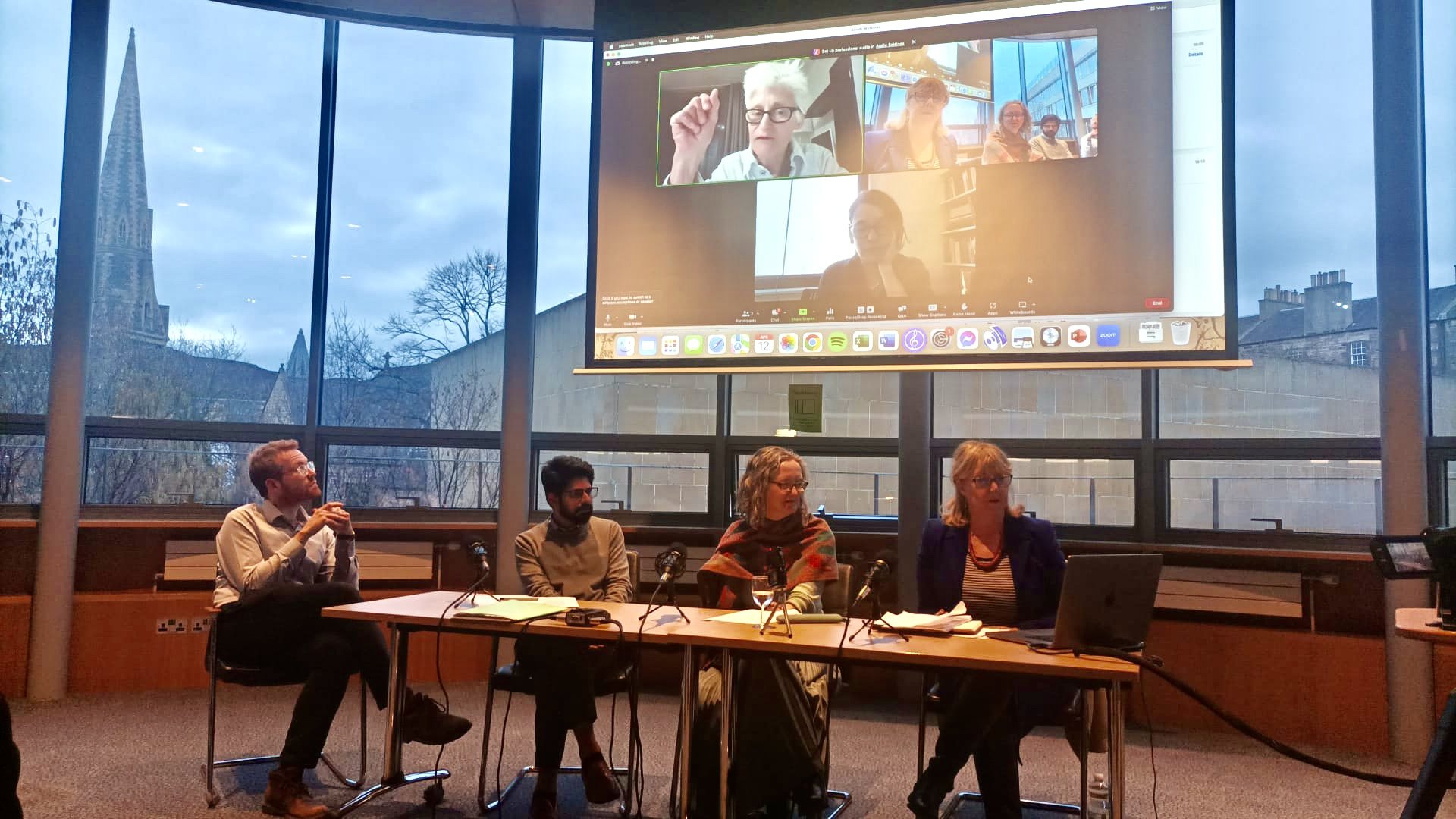
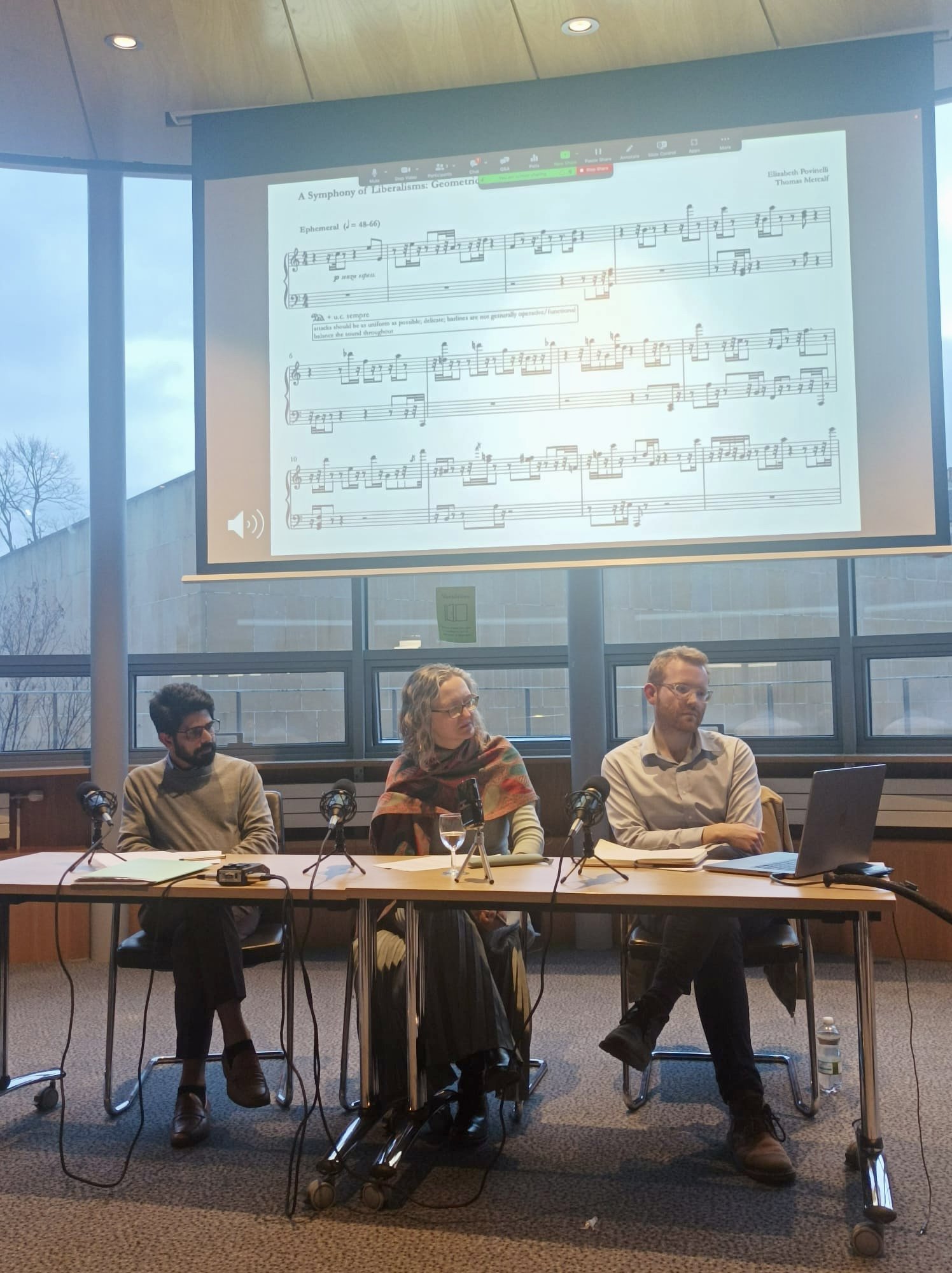
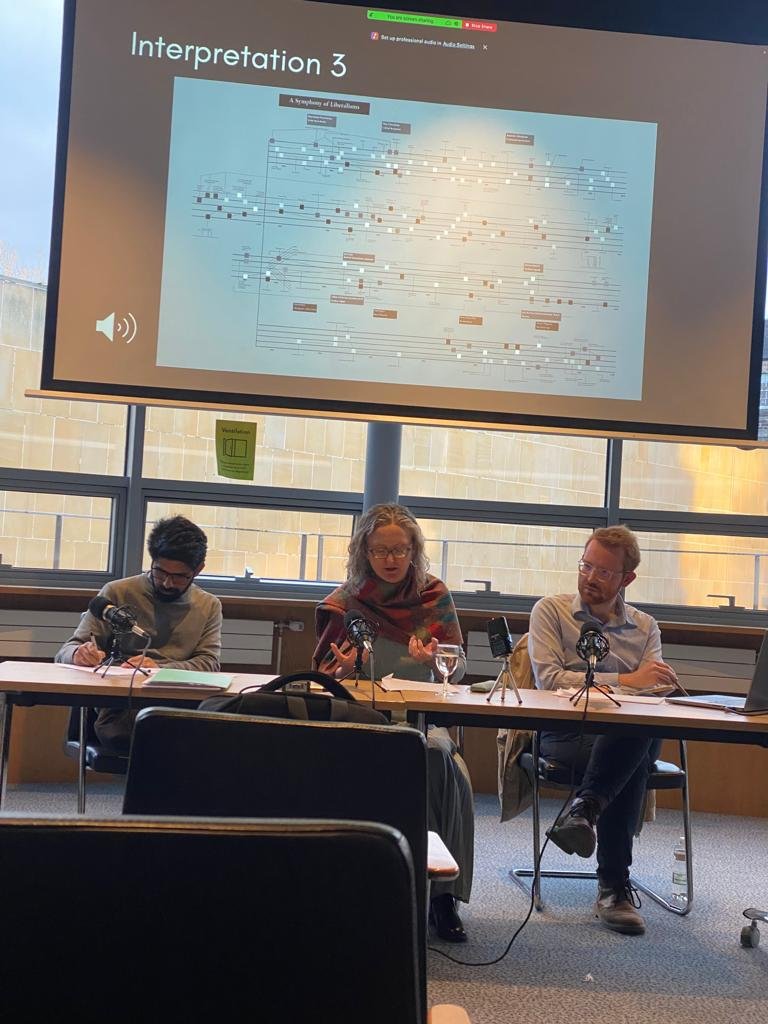
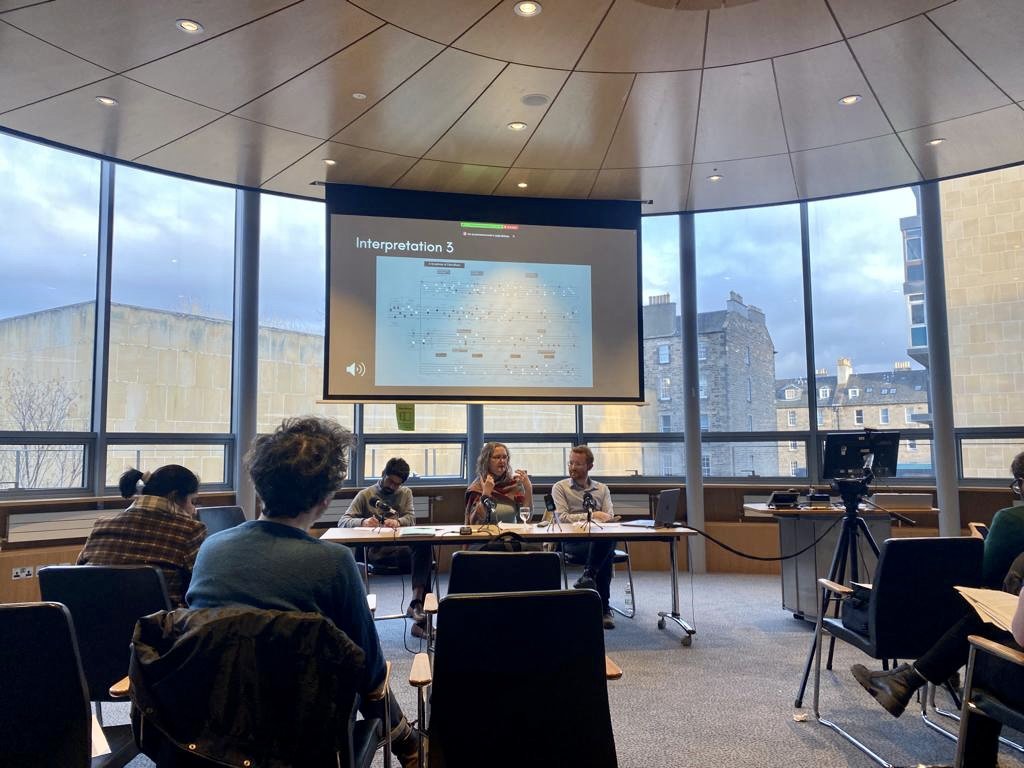
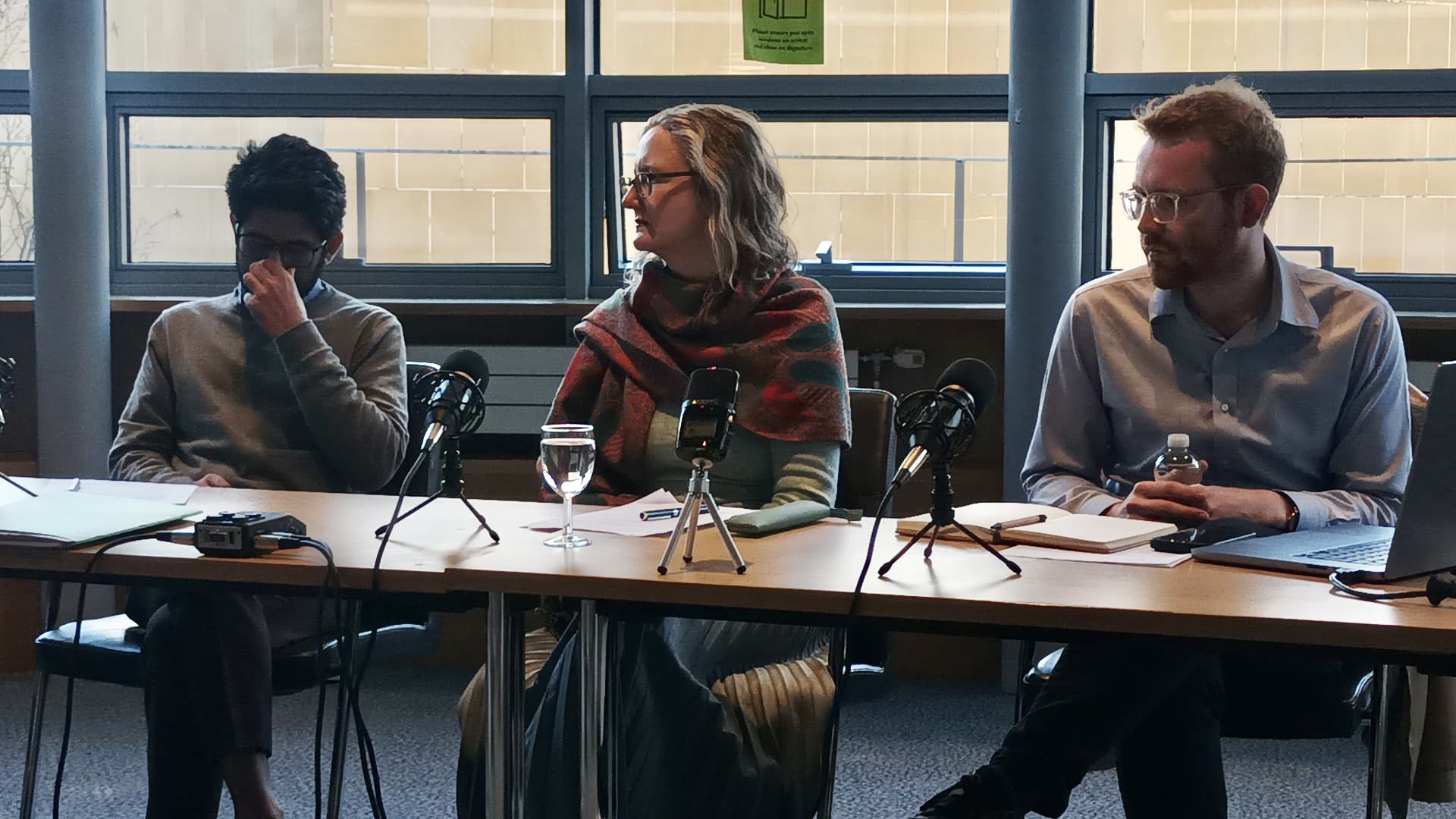
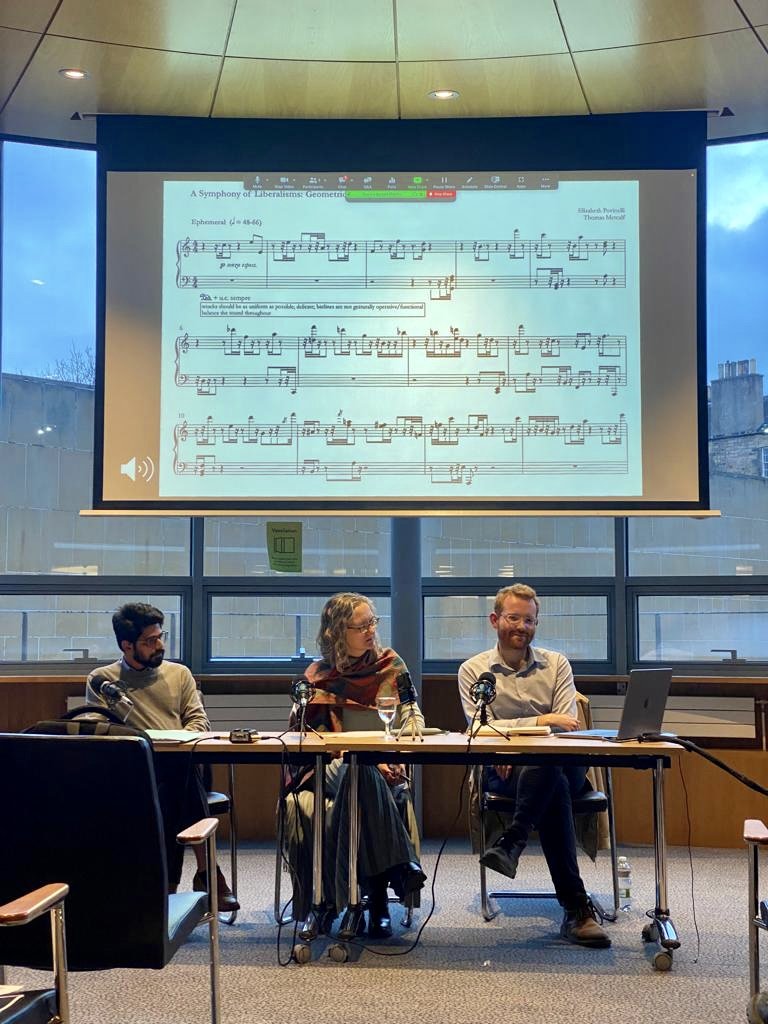
Through collaboration at IASH, Dr. Shakeel Anjum and I devised a workshop which explores Elizabeth Povinelli’s ‘A Symphony of Late Liberalism’ in a multidisciplinary perspective, featuring the author herself, and other distinguished speakers. The programme can be found here, and its description is below:
A Symphony of Late Liberalism appears as a ‘concept-image’ in Elizabeth Povinelli’s Economies of Abandonment (2011), one which represents a critique of liberalism in a transnational, historic, and contemporary assemblage of events. It is further expanded in Geontologies: A Requiem for Late Liberalism, to demonstrate ‘a strange way of periodizing [which] creates an even stranger geography’ visible in the image of the Symphony (2016: 169). The Symphony is presented, in musical terms, as a graphic score: a musical text used for performance which prioritises indeterminacy, pictorialism and/or abstraction, suffused with a maximising of the performer’s agency (in lieu of the traditional composer-performer hierarchy).
The Symphony is a fusion of anthropological, sociological, and musicological design. This workshop hosted five speakers to bring their disciplinary expertise to unravelling the implications of this enigmatic text. These short presentations were interspersed with recorded musical interpretations of the Symphony, provided by pianist David Palmer, to demonstrate the radical potential of the text as performative: how can we ‘sound’ the idea of decolonial resistance?
Photography and/as Music: Junior Anniversary Fellowship, Institute for the Advanced Study of the Humanities, Edinburgh University
This project explores the relationships between photography and/as music composition through a framework of comparative arts, particularly the rhetorical concept of ekphrasis. There is no shortage of music which responds to visual forms, particularly paintings, and a great amount of work has been carried out in fields such as programme music, ekphrastic music, and even computer music, to think about the process and aesthetics of such activities. Photography, however, has remained less prevalent in these studies, despite being of real importance in the field of Visual Studies and Art History. This project aims to address this imbalance, and think about how the specific medium of photography has become entangled with significant musical developments in the 20th century, using composers such as Hector Villa-Lobos (1887-1959), Morton Feldman (1926-1987), Cornelius Cardew (1936-1981), and Fred Frith (b. 1949) to demonstrate this. As well as exploring this central and more theoretical aspect, this project will also incorporate my creative practice as a composer, producing new works which utilise transmedial systems of composition derived from photography.
Reflections on PERLEGO: Methods of Research in Literature and the Visual Arts: 6th-8th April 2022, Freie Universität, Berlin
I was recently invited to contribute to the PERLEGO network’s workshop on methods of research in Literature and Visual Arts, as part of the Oxford-Berlin Partnership, funded by The Oxford Research Centre for the Humanities. This was a fantastic opportunity to immerse myself in an interdisciplinary environment and explore new and diverse approaches to the interaction of image and text, which is an area of my work that I am becoming increasingly focused on.
As the only musicologist on the trip, I felt a little nervous in my status and presence within the group, which consisted of brilliantly talented scholars from the fields of Italian, German, French, and Art History, ranging from postdoctoral to Professorial level. However, such was the enthusiasm and ethos of the group that I felt immediately supported and invigorated by the exciting directions of our research, linked through the wider area of image/text relationships.
The work I presented demonstrated by postdoctoral research plans in the application of parergon theory to transmedial art music, attempting to create a new framework through which to examine the aesthetics of a diverse range of composers in the 20th and 21st centuries. The responses to the work were encouraging, and have given me new insights as to how the work might be situated in more general visual culture methods, supported by our two text discussions focusing on ideas such as the ‘iconic’ turn, and the strengths and weakness of comparative research methods. Indeed, the lateral thinking as to how parerga operate in different arenas (particularly in the concept of the artist’s signature, explored by Prof. Karin Gludovatz), demonstrate and confirm some of my initial thoughts as to the affective nature of the parergon, building upon Derrida’s The Truth in Painting.
This was a thoroughly enlightening experience, and I look forward to contributing to the possible edited volume that might result from the workshop. My thanks to Vittoria Fallanca, Rebecca Bowen, and Sophie König for inviting me, and providing an exploratory space for critical reflection and refinement of the new directions in my research.
Arborescences and Aleatoricism in Graphical Ekphrasis: Folyò, Paths Run Deep, and Erasure.
My work on graphical ekphrasis has often probed the tension between the ‘internal’ and ‘external’ manifestations of the graphic being used, where internal relates to the process of transmedialisation into staff-notation (and the convoluted processes therein), and external is the presentation of the original graphic in the score which relegates compositional control to the performer. The two earliest pixel compositions, DISSOLUTION and Pixelating the River have utilised this tension as part of the musical narrative of each work.
Folyò, bar 50.
Folyò is, to an extent, arelated to these two compositions, since its graphical source is another river map - this time a section of the Danube known as the Danube Bend. Written for Psappha as part of their Composing for Violin & Cimbalom scheme, this work allowed me to explore the possibility of graphically-inflected writing for a more unusual instrument. In this piece, I overlaid the river’s shape over the cimbalom board which, owing to its idiosyncratic pitch layout, creating unusual results which allowed me to get away from the high:low dichotomy found in writing graphically for strings (for example). In order to exploit this contrast, the violin’s material is derived from a more standard pitch/time graph. As a result, there exists a musical dialectic between the two generated pitch sets - despite them being the same graphical source. In the final section of the piece, the notation becomes totally graphic for the cimbalom (where it begins to trace the river shape, zooming in each bar) as the violin performs a kind of cadenza, before joining the cimbalom in graphic notation. By moving from ‘internal’ to ‘external’ process, there is an implied ‘eco-critical’ commentary that posits the relationship between mankind and nature: and perhaps this could be said to be the poetic goal of the ekphrasis. This piece will premiere in June 2021 and a link of the performance can be found here.
Paths Run Deep, bb. 56-57.
Thinking about other natural phenomena in contemporary music, my mind returned to Xenakis, whom I studied in the first years of my DPhil, and his use of ‘arborescences’ (or tree-like structures). After some initial experiments, I produced Paths Run Deep for soprano and piano, which was shortlisted for the Benslow Young Composers Competition 2021. In this piece, the piano material is generated through transcribing a freely-drawn arborescence, and the soprano follows a path through it, moving from one open end to another. The culminates with the insertion of an arborescence graphic within both parts, which both must follow freely - the soprano using glissando and the pianist through tracing the shape on the inside of the instrument (much like the cimbalom in Folyò). The nature of the shape in having these branching paths instils an aleatoric element to the score, which further consolidates the idea of ‘otherness’ of the external graphic - despite it informing all aspects of the work up until that point.
Erasure is a combination of arborescence generation, pixelation, and aleatoric elements. In a way, it represents an attempt to enact graphical ekphrasis on several levels in order to craft a deeply eco-critical commentary. In the opening, we see the transcription of an arborescence like in Paths Run Deep applied to a much higher level of fidelity (utilising glissandi and microtones). Following this exposition, there are varying levels of pixelation applied to the arborescence shape which inform the pointillistic textural presentation. This leads to an extended passage of graphic, aleatoric notation which presents sections of the original arborescence alongside its pixelated derivatives: therefore, creating a spectrum of representation to obfuscation. This work is yet to be performed.
Arrays for solo piano (2020)
Arrays builds on the initial experimentation carried out in All Dead Paper (2020) in the creation of pixel arrays through the varied pixelation of a text. The piece exists in five movements, whose durations are almost totally controlled by the number of arrays generated. Like in the viola in All Dead Paper, the density of pixel layout is used to generate density of attack in the piano (albeit now expanded from a maximum of 4 notes per attack) and processes of randomisation were used upon the rhythmic durational/textual skeletons in order to create a harmonic trajectory through deletion and adjustment. These latter adjustments were made with the poetic, pixelated, text in mind (written by me) which then lent gestural characteristics to each movement. Whilst it is true that each movement explores a different sub-process of using pixel arrays, the entire piece reveals a narrative of (mis)representation, rupture, and erasure that is at the heart of the visual process of pixelation. I am greatly thankful to David Palmer for his insights and advice on this piece.
Arrays
…into the web…
I hear arrays:
Paths followed and forgotten, but
Still sounding. Sounding (un)clear
Until nothings remain.
All Dead Paper for soprano and viola (2020)
All Dead Paper focuses on the musical potential of pixelating text, affecting the visual layout as well as the text’s meaning. The cover illustration shows variations of pixelation on the titular phrase, as well as a line showing the path taken through the array. These pixelated images were analysed and musical details (particularly texture and rhythm) were generated. The metaphor of pixelation is implied through the increasingly nonsensical text in the vocal part, which then begins to semantically deteriorate following a rupture at b. 20.
The text is from Elizabeth Barrett Browning’s (1806-1861) Sonnets from the Portuguese (1846). These sonnets have a deliberately misleading title in order to mask their intimate nature (they are not translations of Portuguese originals, as one would assume), and this seemed appropriate for a musical exploration of a visual process which causes obfuscation. Similarly, the phrase ‘all dead paper’, taken from the opening of the 28th sonnet, particularly appealed to me for the tension between technology and modernity/antiquity, as well as the fact that one of the causes of visual display errors are ‘dead pixels’.
This piece uses multiple levels of pixelation within the same musical space, creating a more challenging teleology of pixelation as a musical form or processes (than works such as Pixelation Variations. The short nature of the piece was a good introduction to this idea, although I hope to expand this method to a larger work in due course.
The score can be found here.
DISSOLUTION for organ (2020)
‘Pixelization’ is the term used in computing when an image becomes blurred through the transformation of the image into a lower resolution. This is the other type of graphic process that I want to explore in composition, contrasting to the idea of stretching, which focuses on one particular portion of a complete image.
For comparative research, I have used the map of the River Thames (used in Pixelating the River below) in its entirety to generate a 12-note row (not totally chromatic). Following this, I have used an averaging process to reduce the data from 12 notes, to 11, and so on, down to 1. This reflects the data loss of the image being reduced to a single pixel through the averaging of data.
A collaborative recording with Daniel Mathieson, as well as the full score, is available here.
[This piece, until December 2020, was titled Pixelation Variations.]
Pixelating the River for string quartet (2020)
Pixelation:
1. in computer graphics and digital photography, to cause (an image) to break up into pixels, as by over–enlarging the image.
2. to blur (parts of a digital image) by creating unclear, pixel-like patches, for purposes of censorship or to maintain the anonymity of the subject.
–
When an image is stretched or magnified in a given visual boundary, its makeup becomes distorted due to the increased size of the pixels limited within that boundary. However, one may take the view that, actually, as the pixels come into view, we can see how a subsection of the full image is constructed more precisely. Through this idea of focus and magnification of a given graphical input, this piece will try to translate an original graphic (in this case, a map of the River Thames), as well as several levels of pixelation of that graphic, into music.
–
I have long been interested in the idea of how pixelation can affect graphical methods of composition, particularly in the generation of material. Pixelation is my first attempt at this process, trying to treat the graphic in multiple different ways at both surface and structural levels in the composition. I hope to continue this research and strive for a method that is flexible and can be applied to other ensemble-types.
This piece will form the central focus of the ‘Pixelating the River': engagement with contemporary music through graphical inputs project, generously funded by the Humanities Cultural Programme Fund at Oxford University. It will be performed by the internationally-renowned Kreutzer Quartet, whom I am working closely with until its premiere in May 2021.
Vignettes of a Pixelated River (2020) functions as a set of ‘soliloquies’ within the larger structure. There will be a piece of this kind for each instrument of the quartet, to create a networked structure between instruments and material at varying levels of pixelation.
A perusal score can be accessed here.
Graphical Data Sets as Compositional Structure: Sonification of Colour Graphs in RGB for clarinet and piano
In his ‘Introduction to Data Sonification’, David Worrall cites key definitions of data sonification, which centre on the idea of creating ‘mappings’ of data (inputs) to sound (outputs). Taking the less–complex univariate form of data sonification, we can use Scaletti’s definition as a starting point for applications to composition:
“a mapping of numerically represented relationsin some domain under study in relations to an acoustic domain for the purposes of interpreting, understanding, or communication relations in the domain under study.”[1]
My piece, RGB, for clarinet and piano, derives its structure from the sonification of data within an RGB (red–green–blue) colour analysis of Jackson Pollock’s Out of the Web:
This data set uses ‘position’ in the painting is the independent variable, versus RGB colour saturation as the dependent. Compositional parameters (‘mappings’) were chosen, informed by the data’s limits, with these decisions strictly controlling the possibilitiesof composition through conditional ‘rules’. As Scaletti highlights, through the establishment of a mapping from data to sound, the data–set (graph) can now be understood in a different medium. This connection may create visual/aural semiotic connections between the graph and the sound which will allow data to be understood by the listener under this new perspective, thus acting as metaphor.
The Oxford Research Centre for the Humanities (TORCH) have featured my abridgement of the research paper on their website in April 2020: https://torch.web.ox.ac.uk/article/rgb-a-brief-introduction-to-data-sonification-as-compositional-process
[1]C. Scaletti in D. Worrall, ‘Introduction to Data Sonification’, in R. T. Dean (ed.), The Oxford Handbook of Computer Music, OUP, 2011, p.312-313 [italics mine]
‘UPIC: Graphic Interfaces for Notation’ Conference, 28-29 Sept. 2018, ZKM | Karlsruhe, Germany
As part of my research, I attended the first ever conference on the UPIC computer system, featuring key speakers from UPIC’s history, as well as leading composers, developers, and musicologists.
The UPIC system is central to my research, as this was the first attempt to translate freely drawn images to sound in order to create compositions.
It seems clear to me that many of the new composers who have continued in the vain of Xenakis’s thought process have perhaps lost the focus of the UPIC’s philosophy of accessible creation tool. Some of the papers delivered at this conference were incredibly technical, creating new electroacoustic music programs that push the limit of spatial representations in music. An interesting point was raised during the panel discussed by Alain Depres, composer and initial collaborator on the UPIC’s creation, which regarded this issue of complexity for complexity’s sake. I am in agreement that whilst electroacoustic music should follow the natural path of innovation, the place of a traditional music compositional philosophy in its future begins to exist less and less. It seems that the use of a graphic as a starting point seems to have fallen out of fashion for the sake of designing complex coded systems and algorithms which can manipulate a single sound source.
The distinction between a graphic score, and a piece of music which uses graphics as a starting point in the compositional process is also a key distinction; one I will continue to explore.
Nonetheless, this conference provided many thought-provoking points of view regarding the role of graphics in composition, and I look forward to integrating it into my research further.









